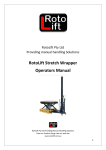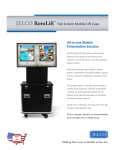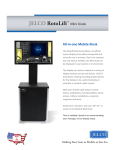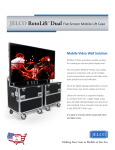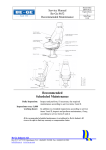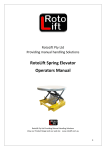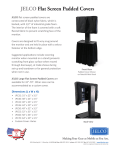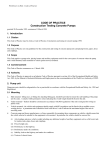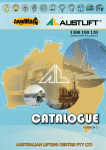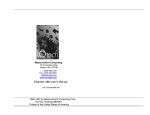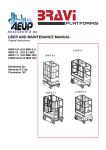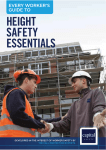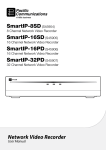Download Hydraulic Lift Table Operators Manual
Transcript
RotoLift Pty Ltd Providing manual handling Solutions Hydraulic Lift Table Operators Manual RotoLift Pty Ltd Providing Manual Handling Solutions View our Product Range visit our web site www.rotolift.com.au ROTOLIFT Hydraulic Lift Table User Manual Section 1. Introduction 2. Safety 3. Transit Damage 4. Installation 5. Electrical Supply 6. Operational Restriction 7. Operating The Lifter For The First Time 8. Upper Height Limit Switch 9. Flow Controller 10. Operating The Lift Table 11. Load Capacity 12. Pressure Relief Valve 13. Duty Cycle 14. Visual Inspection of Hydraulic System 15. Visual Inspection of Mechanical Mechanism 16. Visual Inspection of Electrical Equipment 17. Function Check of Upper Height Limit Switch 18. Warranty 19. Hazard Identification, Risk Assessment & Control 1. INTRODUCTION Lift tables (known also as hydraulic scissor lifts) are used to lower or elevate goods at the touch of a button. Typical uses include the loading and unloading of pallets, positioning of goods at the right height to suit individual workers, movement of goods at loading docks from one level to another or incorporation into a production line where it is automatically controlled. RotoLift manufactures a wide range of hydraulic lift tables. A scissor mechanism supports the platform and is powered by a hydraulic cylinder( s). Due to the considerable force of the tables, safety is important. A safety bar is incorporated in the underside of the platform which, when lifted, will halt the descent of the table immediately. This provides built in protection against the risk of crush injuries, a concertina style safety skirt is also available as an option. The tables are built to withstand the rigours of harsh industrial conditions and can be modified to suit different applications. Roto Lift tables are designed for lifting and vertical positioning of equipment and materials in a wide variety of industrial settings. They are not designed to carry personnel unless specifically modified. The instructions in this manual are not necessarily all-inclusive, as Roto Lift cannot anticipate all situations. In the interests of safety please read the entire manual carefully and are familiar with its contents before installing or using the lift table. If in doubt about the appropriate procedure, contact your RotoLift agent. This instruction manual is not intended to be or create any other warranty, express or implied, including any implied warranty of merchantability or fitness for a certain purpose, all of which are expressly excluded. RotoLift's obligation under warranty is limited to the repair or replacement of defective components, which shall be the buyer's sole remedy and RotoLift, shall not be liable for any loss, injury or damage of any kind resulting from the lift table. 2. SAFETY The safety of all persons operating, maintaining, repairing, or in the vicinity of the lift table is of paramount concern to RotoLift. The lift table is a powerful machine with moving parts and is capable of causing personal injury or death if proper precautions are not taken. RotoLift has identified certain hazards, which may occur in the use of the lift table, and provide instructions or precautions to avoid these hazards. In some cases, RotoLift has also pointed out that consequences may occur if RotoLift instructions or precautions are not followed. RotoLift uses the following system of identifying the severity of the hazards associated with its products. "DANGER"- Immediate hazard which will result in severe personal injury or death. "WARNING"- Hazard or unsafe practice that could result in severe personal injury or death. "CAUTION"- Hazard or unsafe practice which could result in minor personal injury or property damage. The User MUST apply the maintenance chock before entering area beneath the platform. To apply the maintenance chock, remove the load and fully raise the lift table. Rotate the chock into position and then lower the lift table so that the lower roller rests against the chock. WARNING- Inspect the maintenance chock for any damage and operation prior to use. The maintenance chock must be set into position prior to any work being undertaken on the unit, it is essential it is used to support the lift table safely. SAFETY (continued) To release the maintenance chocks/s, raise the lift table and rotate the maintenance chock out of the roller path and into its rest position. It is essential that the lift table is raised from the maintenance chock under its own power. This is the only way to ensure that the hydraulic system can hold the weight of the lift table. Do not force the maintenance chock out of the roller path when the roller is resting on the maintenance chock. 3. TRANSIT DAMAGE Visual inspect the lift table for signs of damage in transit, including hydraulic hoses, piping and fittings and electrical equipment and cabling. If there is evidence of damage, contact RotoLift before using the lift table. DANGERThe lift table uses a power supply of up to 415 VA.C. This voltage can kill. Do not work on the electrical parts unless you are a qualified electrician. DANGERProceed with caution if there is any evidence of hydraulic damage. Damaged hoses, piping or fittings may result in the platform plummeting. Before attempting to work on the hydraulic system or perform any work beneath the platform, apply maintenance chock. 4. INSTALLATION The lift table should be levelled and secured to the floor by bolting through the floor holding down lugs welded to the base frame with 12mm masonry anchors. The lift table base must be supported along its length by the floor. If it is placed on a level and flat concrete floor, the lift table can be bolted directly onto the floor. If the floor is sloping or uneven, the lift table base should be grouted or shimmed. WARNINGThe lift table base must be supported along its length. It is not designed to span from end to end. If you wish to raise the base above floor lever, consult RotoLift regarding the adequacy of the supporting structure. 5. ELECTRICAL SUPPLY DANGERThe lift table uses a power supply of up to 415 VA.C. This voltage can kill. Do not work on the electrical parts unless you are a qualified electrician. RotoLift tables are usually supplied with a power cable and plug that can be plugged in to the appropriate power outlet. Three phase lift table require a 415 V four-pin 10 amp outlet. Single-phase lift tables require a 240V 10 amp outlet, it is recommended that the unit be plugged directly into the mains supply and not via a double adapter or run other appliances from the same outlet. CAUTIONTo reduce the effects of the voltage drop, use only heavy-duty extension leads and do not use more than 10 metres of extension lead. Excessive voltage drop may result in failure of the motor or other electrical components. All RotoLift tables incorporate low voltage controls to enhance operator safety. ELECTRICAL SUPPLY (continued) Three phase lift tables incorporate a remote electrical enclosure containing low voltage control supply and motor switch gear. The enclosure is connected to the lift table via a flexible cable. WARNINGAustralian standard AS 1418.8 requires lift tables to be protected by earth leakage protection (Clause 3.5.6(e)), As earth leakage protection is usually effected at the power outlet, it has not been incorporated into the lift table. Be sure that the outlet used protected. CAUTIONYou may choose to remove the plug supplied and wire directly to a power Source. Australian standard AS1418.8 requires an isolator adjacent to the lift table. Be sure to incorporate an isolator if you hard wire your Lifter directly to a power source. 6. OPERATIONAL RESTRICTION a) Wash-down. The standard RotoLift lift table electrical equipment is rated to the degree of protection IP43 and is not regarded as being waterproof or suitable for wash-down. RotoLift can supply lift tables to the IP56 degree of protection that are suitable for wash-down or external use. b) Hazardous Environment The standard RotoLift lift table electrical equipment is not suitable for use in flammable environments and must never be used when such hazard exists. RotoLift can supply specially modified lift tables suitable for hazardous locations to class 1 Zone 2 or DIP rating. c) Personnel The standard RotoLift table is designed for lifting goods only and should not be used as a personnel lift. RotoLift can supply personnel lifts to AS1735.3 or lifts for disabled personnel AS1735.15 if required. 7. OPERATING THE LIFT TABLE FOR THE FIRST TIME Your RotoLift table has been tested before leaving the factory; however, the Motor direction should be checked upon initial operation. The motor direction of three phase lift tables must be checked. It is possible that the phase orientation of your power supply is different from that used to test the lift table in the factory and that the motor is running in the wrong direction. Press the "UP" control and observe the lift table, If the unit does not begin to lift within three seconds, the motor will be running in the wrong direction. If this is the case, do not continue to run the motor. Ask your electrician to correct the motor direction. DANGERThe three-phase power supply is 415V A.C. This voltage can kill. Do not work on the electrical parts unless you are a qualified electrician. Be certain to isolate the supply before performing any electrical work. 8. UPPER HEIGHT LIMIT SWITCH The Upper Height limit will halt the upward travel of the lift table before the bottom rollers run into the fixed stop blocks. The upper limit does not affect the downward travel. The Upper Height limit has been set in the factory but should be checked in the event that its setting has been disturbed in transit. Fully raise the table and allow it to be stopped by the upper height limit switch. There should be 25 to 50mm of roller travel remaining before the rollers run into the stop blocks. The upper limit switch can be adjusted; this should be done by your electrician. CAUTION: If the Upper limit switch is not adjusted correctly, the rollers may run into the fixed stops, the motor will not automatically cut out. If this is the case, do not continue to run the motor, you may cause damage to the unit, Alert your electrician to the fault WARNING: Before attempting to adjust the up limit or perform any work beneath the platform apply the maintenance chock. 9. FLOW CONTROLLER An adjustable flow controller is located at the base of the cylinders, it is used to adjust the speed of the down travel, It has no effect on the speed of the up travel. Turning the knurled knob on the flow controller clockwise will decrease the down speed, turning the knob anti-clockwise will increase the down speed. Adjustment of the flow control valve may be required to suit your particular product load weight; if the valve is adjusted to maximum and your product load weight is light the table may not lower when the foot pedal is actuated, alternatively if the flow control valve is adjusted to minimum and your product load weight is heavy, when the foot pedal is actuated the table will lower in a very quick unsafe manner. Warning: Before attempting to adjust the flow controller or perform any work beneath the platform, be sure to apply maintenance chock. Do not adjust the flow controller whilst lowering the lift table. 10. OPERATING THE LIFT TABLE Basic Operation The lift table is provided with a Footswitch controller. All controllers are the "Deadman" type (i.e, the lift table only operates when the controller is depressed). The up travel is automatically stopped at the top of travel by an adjustable limit switch. The down travel is halted only if the safety chock has been put into position. The down speed is adjustable by flow controller as describe in section 7. The speed is not adjustable. WARNING: As the lift table moves up and down, "pinch points" are created where the scissor legs cross and where the legs meet the base and platform. Be careful and observant when operating the lift table that nobody is in danger of becoming caught in the moving parts. Your OH&S Manager should arrange for all operators to be appropriately trained to operate the unit 11. LOAD CAPACITY The load capacity is placarded on the sides of the platform, to enable the safe ongoing operation of the lift table, ensure that the capacity placarding remains legible. The load capacity is based on the load applied centrally and uniformly to the platform, as if the load were a full pallet or similar, If the load is not central or if point loading is involved, please consult RotoLift before using the table. 12. PRESSURE RELEIF VALVE The hydraulic pump incorporates a pressure relief valve, its purpose is to limit the maximum pressure of the system and protect hoses and seals from damage caused by excessive pressure, in normal operation it should never be activated. This valve is set before the lift table leaves the factory and should require no further adjustment. If you hear a squealing noise from the pump (usually accompanied by a change in pitch of the motor) during up travel, the pressure relief valve is operating, If this occurs, stop the lift table immediately, If not, the pump may quickly overheat and be damaged. The most likely cause is over loading of the lift table, Remove the load, lower the lift table and attempt to raise, If the relief valve still operates, a hydraulic fault is likely. If so, do not continue to operate the lift table and contact your RotoLift agent. 13. DUTY CYCLE Your RotoLift lift table is designed for intermittent use commensurate with manual loading and unloading operations. To prevent overheating of the motor, avoid "jogging" the motor to position the platform, for accurate positioning, it is preferable to raise the above required location and jog the down control. Motor starting should not exceed 8 starts per hour for single phase motors and 16 starts per hour for three phase motors, exceeding these parameters may result in overheating of the motor. 14. VISUAL INSPECTION OF HYDRAULIC SYSTEM a) Inspect the hydraulic system for leaks. DANGER: It is essential to apply the maintenance chock before attempting to tighten or dismantle hydraulic fittings. If tightening does not fix any leaking fittings, dismantle, clean and reassemble the fittings, do not over-tighten! JIC swivel fittings (all hose ends) and Swagelok fittings (all steel pipe ends) should be reassembled with a light smear of clean oil. NPT tapered thread fittings should be cleaned and new, clean thread sealant applied, Use only Loctite 567 thread sealing paste (white paste) or compatible equivalent. b) Inspect the hydraulic hoses and piping for chafing and damage. c) Check that the small breather hole in the oil tank filler plug is not blocked. d) Inspect the clear vent tube for signs of cylinder bypass. Raise the lift table whist observing the contents of the tube, a small amount of oil in the vent tube is normal, this oil will return to the tank as the lift table is raised. If the vent tube instantly completely fills with oil as the lift table nears the top of its stroke it is likely that the cylinder seals are leaking, The lift table can still be used in this condition but may drift down when not in use and may not lift the rated load. 15. VISUAL INSPECTION OF MECANICAL MECHANISM Inspect all pivot points for signs of wear (4 leg pivots, 4 rollers, 2 centre pivots, cylinder rod pivots). All pivots are either Teflon impregnated D.U bushes or oil impregnated sintered bronze bushes. Both are "lubricated for life" although their life will be extended by additional periodic lubrication with light oil or WD40. 16 VISUAL INSPECTION OF ELECTRICAL EQUIPMENT Inspect electrical installation for damage to cables and devices, Pay particular attention to trailing cables and to those cables that flex with the movement of the lift cables. DANGER: The lift table uses a power supply of up to 415V A.C. This voltage can kill. Do not work on the electrical supply unless you are a qualified electrician, isolate the supply before working on the electrical system. 17. FUNCTION CHECK OF UPPER HEIGHT LIMIT SWITCH Inspect the Upper Height limit switch for physical damage and adjustment, Perform a functional check of the up limit switch as described in Section 8. 18. WARRANTY 18.1 It is agreed that the product purchased is subject to the following LIMITED WARRANTY and no other 18.2 RotoLift warrants product to be free from defects in material or workmanship for a period of twelve months from date of shipment. 18.3 This warranty shall not cover failure or defective operation caused by operation in excess of recommended capacities, misuse, negligence or accident, or alteration or repair not authorized by RotoLift. 18.4 RotoLift's obligation under this warranty is limited to the replacement or repair of defective components at the factory, or at the discretion of RotoLift, at a location designated by RotoLift 18.5 RotoLift will not be liable for any loss, injury or damage to persons or property, nor for damages of any kind resulting from failure or defective operation of any materials or equipment furnished. 18.6 Components and accessories not manufactured by RotoLift are not included in this warranty as their respective manufactures warrant them separately. a. DISCLAIMER OR IMPLIED WARRANTY OF MERCHANTABILITY RotoLift and buyer agree that the implied warranty of merchantability is excluded from this transaction and shall not apply to the goods involved in this transaction. h. DISCLAIMER OF IMPLIED WARRANTY OF FITNESS FOR PARTICULAR PURPOSE RotoLift and buyer agree that the implied warranty of fitness for particular purpose is excluded from this transition and shall not apply to the goods involved in this transaction. c. DISCLAIMER OF EXPRESS WARRANTY RotoLift agents; or dealer's agents, or distributors' agents may have made oral statements about the product and equipment describe in this transition. Such statements do not constitute warranties, and buyer acknowledges that it did not rely on and agrees not to rely on such statements. The buyer also agrees that such statements are not part of this transaction. d. CONSEUENTIAL DAMAGES RotoLift and buyer agree that any claim made by buyer, which is inconsistent with warranty remedies, provided with the product and equipment, and in particular consequential damages, are expressly excluded. e. MERGER This warranty agreement constitution a final written expression of all the terms and condition of this warranty and is a complete and exclusive statement of those terms. f. ROTO LIFT EXCLUDES AND LIMITS LIABILITY 18.7 RotoLift does not exclude or limit the application of any statutory provision including a provision of the Trade Practices Act 1974 where to do so would: - 1. Contravene that statute or; 11. Cause any part of this clause to be void. 18.8 RotoLift excludes for itself and for any third party supplier of componentry or software incorporated in any product or equipment, all liability for all claims, expenses, losses and damages made against or incurred or suffered by Buyer of the product or equipment, directly including without limitation lost profits arising out of:(a) Buyer misusing or using any product: (b) Buyer not being able to use any product; (c) Negligence of RotoLift or its employees, Contractors or Agents or of any supplier of componentry or software incorporated in the product in connection with the performance of RotoLift obligations. 19. HAZARD IDENTIFICATION, RISK ASSESSMENT & CONTROL 19.1 Crush and shearing injuries as a consequence of pinch points The lift tables have pinch points where the scissor legs meet and where the legs meet the platform and the base. A crush injury is possible if a person's body fouls these areas or is caught between the lift table platform and the floor or other fixtures nearby. 19.2 Risk assessment The risk of such an injury is slight, The pinch points develop slowly as the lift table moves and are located well within the machine, not close to the operator. There is little serious injury history associated with lift tables in Australia. If sustained however, the injuries could be serious or fatal. 19.3 Control measures Deadman controls The lift tables are fitted with deadman controls, This means that the lift table will only operate while the control is pressed. The release of the control will halt the movement of the lift table. Education Train operators to ensure that no-one is likely to be caught in the moving parts before operating the lift table, Clear the area around the lift table before operation. 19.4 Crush injuries due to uncontrolled descent During maintenance procedures, the lift table may be tampered with in such a way that the lift table could plummet. This may also occur if the mechanism or hydraulic system is damaged or tampered with. 19.5 Risk assessment If repaired and maintained according to the manufacturer's instructions, the risk is very slight, but injuries could be serious or fatal. 19.6 Control measures Maintenance chocks A maintenance chock is incorporated into the base of the lift tables. This is flipped into the roller path when maintenance is to be carried out, when applied, the chock will prevent the fall of the lift table platform. Flow controller A flow controller is fitted to the lift table to prevent the sudden loss of oil from the cylinders. Instruct operators not to adjust the flow controller whilst lowering the lift table. 19.7 Electrocution The lift tables require a 240V, 50Hz single phase or 415V 50Hz three phase power source, If the electrical system is damaged, there is the potential for electrical leakage. 19.8 Risk assessment The risk of damage to the electrical system is generally low, although this would need to be assessed in situ, An electric shock may lead to serious injury or death. 19.9 Control measures Earth leakage protection The Australian standard AS 1418.8 requires lift tables to be protected by earth leakage protection (Clause 3.5.6.(e) ). As earth leakage protection is usually effected at the power outlet, it has not been incorporated into the lift table. Be sure that the outlet used is protected. Qualified electrical Personal/labour Should work be required on the electrical system of the lift table, ensure that a qualified electrician is used. Training Operators should be trained to inspect cabling daily for damage, if any damage is found, the machine should be turned off at the supply Tagged out of service and repaired by a qualified electrician. 19.10 High pressure fluid A person may come into contact with hydraulic fluid under pressure if a hydraulic component fails. 19.11 Risk assessment The risk of such injury is very slight, but puncture wounds could be sustained or serious injury may occur if the fluid came into contact with eyes. 19.12 Control measures Regularly check the hydraulic system for leaks and/or damage. Do not exceed the load rating of the lift table. 19.13 Slipping, tripping and falling A person may slip on the floor surface or trip on the plant while the lift table is lowered. 19.14 Risk assessment The risk of slipping on the platform is negligible if the lift tables are used purely as they are intended. Slipping, tripping and falling could cause bruising and perhaps more serious injuries. 19.15 Control measures Do not allow persons to stand on the lift table, Keep the surface of the platform clean. Keep pedestrian area away from the lift table work area. 19.16 Crushing through falling plant or loads Unsecured or unstable loads may fall off the elevated platform onto the operator or other people. A lift table placed on an incline, an uneven surface may tip and fall onto the operator or other people. 19.17 Risk assessment If the load is placed centrally on the lift table and is compactly stacked, and if the table is located on a solid, level concrete floor, then the risk is low. Injuries that may occur could be serious. 19.18 Control measures Ensure that loads are stable and stacked securely on the lift table. Separate the lift table work area and pedestrian areas, Ensure the area around the lift table is clear of persons before operation. Do not exceed the load capacity of the lift tables. Ensure that the lift table is positioned on a level, smooth concrete floor that can carry the combined mass of the lift table and its load capacity. Ensure that the plant is securely anchored to the floor before operating the lift table. Should you require any further information on RotoLift Products please contact RotoLift Pty Ltd direct at; Factory 4 / 53 Malvern Street Bayswater Victoria 3153 Phone (03) 9720 7668 Fax (03) 9720 4233 Email [email protected]



















